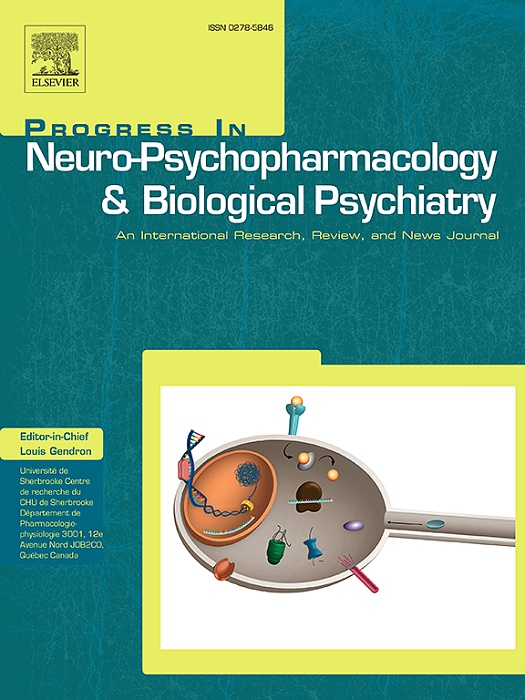毒蕈碱乙酰胆碱受体介导的胆碱能神经传递参与了 TMS-EEG 反应。
IF 5.3
2区 医学
Q1 CLINICAL NEUROLOGY
Progress in Neuro-Psychopharmacology & Biological Psychiatry
Pub Date : 2024-10-09
DOI:10.1016/j.pnpbp.2024.111167
引用次数: 0
摘要
经颅磁刺激和脑电图(TMS-EEG)的结合正在成为研究健康和疾病中大脑功能的重要工具。然而,经颅磁刺激脑电图反应(包括经颅磁刺激诱发的脑电图电位(TEP)和经颅磁刺激诱发的脑电图振荡(TIO))的详细神经机制在很大程度上仍不为人所知。将 TMS-EEG 与药物干预相结合为阐明特定受体介导的神经传递在这些反应中的作用提供了一个独特的机会。在此,我们采用随机、安慰剂对照交叉设计,通过评估 mAChR 拮抗剂对 24 名健康参与者的 TEP 和 TIO 的影响,研究了毒蕈碱乙酰胆碱受体(mAChR)介导的胆碱能神经递质参与 TMS-EEG 反应的情况。在口服单剂量东莨菪碱(一种非选择性 mAChR 拮抗剂)、比哌利登(一种 M1 mAChR 拮抗剂)或安慰剂前后,针对左侧内侧前额叶皮层(mPFC)、角回(AG)和辅助运动区(SMA)进行 TMS,测量 TEP 和 TIO。结果表明,mAChR介导的胆碱能神经递质以目标特异性的方式在TEPs中发挥作用,而不是TIOs。具体来说,当TMS作用于SMA而非mPFC或AG时,东莨菪碱可明显增加刺激后约40至63毫秒之间的局部TEP成分的振幅。比哌立登也产生了类似但不太明显的效应。重要的是,这些 mAChR 拮抗剂对 TEP 的影响与 TMS 相关感觉刺激引起的感觉诱发 EEG 电位的影响无关。这些发现拓展了我们对 TMS-EEG 生理学的理解,为其在生理学和临床研究中的应用提供了启示。本文章由计算机程序翻译,如有差异,请以英文原文为准。
Involvement of muscarinic acetylcholine receptor-mediated cholinergic neurotransmission in TMS–EEG responses
The combination of transcranial magnetic stimulation and electroencephalography (TMS–EEG) is emerging as a valuable tool for investigating brain functions in health and disease. However, the detailed neural mechanisms underlying TMS–EEG responses, including TMS-evoked EEG potentials (TEPs) and TMS-induced EEG oscillations (TIOs), remain largely unknown. Combining TMS–EEG with pharmacological interventions provides a unique opportunity to elucidate the roles of specific receptor-mediated neurotransmissions in these responses. Here, we investigated the involvement of muscarinic acetylcholine receptor (mAChR)-mediated cholinergic neurotransmission in TMS–EEG responses by evaluating the effects of mAChR antagonists on TEPs and TIOs in twenty-four healthy participants using a randomized, placebo-controlled crossover design. TEPs and TIOs were measured before and after administering a single oral dose of scopolamine (a non-selective mAChR antagonist), biperiden (an M1 mAChR antagonist), or placebo, with TMS targeting the left medial prefrontal cortex (mPFC), angular gyrus (AG), and supplementary motor area (SMA). The results indicated that mAChR-mediated cholinergic neurotransmission played a role in TEPs, but not TIOs, in a target-specific manner. Specifically, scopolamine significantly increased the amplitude of a local TEP component between approximately 40 and 63 ms post-stimulus when TMS was applied to the SMA, but not the mPFC or AG. Biperiden produced a similar but less pronounced effect. Importantly, the effects of these mAChR antagonists on TEPs were independent of those on sensory-evoked EEG potentials caused by TMS-associated sensory stimulation. These findings expand our understanding of TMS–EEG physiology, providing insights for its application in physiological and clinical research.
求助全文
通过发布文献求助,成功后即可免费获取论文全文。
去求助
来源期刊
CiteScore
12.00
自引率
1.80%
发文量
153
审稿时长
56 days
期刊介绍:
Progress in Neuro-Psychopharmacology & Biological Psychiatry is an international and multidisciplinary journal which aims to ensure the rapid publication of authoritative reviews and research papers dealing with experimental and clinical aspects of neuro-psychopharmacology and biological psychiatry. Issues of the journal are regularly devoted wholly in or in part to a topical subject.
Progress in Neuro-Psychopharmacology & Biological Psychiatry does not publish work on the actions of biological extracts unless the pharmacological active molecular substrate and/or specific receptor binding properties of the extract compounds are elucidated.

 求助内容:
求助内容: 应助结果提醒方式:
应助结果提醒方式:


